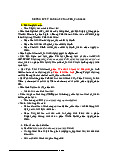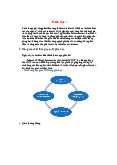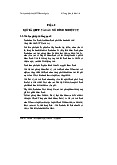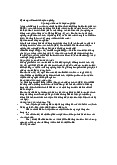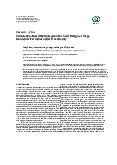



















Preview text:
THE PRODUCT MANAGER HANDBOOK Compiled by Carl Shan Designed by Brittany Cheng INTRODUCTION
“What in the world is Product Management?”
It was the above question, and my burning desire to learn the answer, that sparked the cre- ation of this handbook.
You see, the inspiration for this handbook came when I was hired as an intern Product Man-
ager in a large education technology company. At that point, although I had successfully im-
pressed the interviewers with my background and passion for education to secure the job, I
still had relatively little idea what it really meant to be a Product Manager.
Worried that I wouldn’t be able to excel in my role, I decided to spend the few months until
my internship connecting with, interviewing, and learning from some of the best Product Managers in the field.
Fortunately, I was able to get in touch with some of the most brilliant, thoughtful and helpful
individuals working in Product Management. Hailing from companies like Google, Facebook
and Microsoft, these Product Managers not only agreed to share their insights with me, but
they also generously gave permission for their thoughts to be included in this handbook to be
distributed publicly with the entire world.
What you have in front of you are the distilled and polished gems of wisdom that were un-
earthed during the course of all these conversations.
This handbook provides invaluable insight for anyone interested in working as a Product
Manager or who simply wants to learn about what it takes to build an excellent product. In
reading the conversations contained here, you will find career advice, product advice and even life advice.
My dream is that the insights contained within this handbook will serve as inspiration for
people everywhere to create amazing products that improve the world. Enjoy. Carl Shan CONTENTS
HOW TO GET A JOB AS A PM 4 INTERVIEWS 8 JEREMY CARR 8 CLEARSLIDE JASON SHAH 13 YAMMER LUKE SEGARS 17 GOOGLE LILY HE 21 WORK MARKET SUNIL SAHA 25 PERKVILLE SEAN GABRIEL 29 MICROSOFT DAVID SHEIN 34 FACEBOOK PAUL ROSANIA 37 TWITTER LAYLA AMJADI 45 FACEBOOK AVICHAL GARG 52 FACEBOOK ACKNOWLEDGMENTS 58
ABOUT CARL & BRITTANY 59
*Download a FREE PDF version of this handbook at ThePMHandbook.com HOW TO GET A JOB AS A PRODUCT MANAGER
Gayle Laakmann McDowell and Jackie Bavaro
People go to medical school to become a doctor and law school to become a lawyer, but what
do they do to become a product manager? Business school is one option, but there are many
others. Product management jobs are within reach of new graduates.
How do you get into Product Management straight out of college?
Big tech companies like Google, Microsoft, and Facebook are always hiring new grad prod-
uct managers1. Write up your résumé and head to your school’s career fair to chat with the recruiters.
If these companies aren’t recruiting at your school, you’ll need to network. Find friends who
can connect you with a recruiter, or try to connect with employees from the company using
Twitter, Quora, LinkedIn, or their blogs. Many employees are happy to refer people who have
shown a genuine interest in the company and have a strong resume.
Some startups will also hire fresh college graduates into Product Manager roles, but this is
more unusual. Typically, to land such a role, you’ll have to really stand out as a PM candidate
and get your foot in through your personal / professional network.
1 Note: The name of this role might differ from company to company. Microsoft hires many new grads for Program Manager
roles, which is the equivalent of other companies’ product manager roles. Microsoft also has a Product Manager role, but this is
more of a marketing function and is usually not entry level. Google has an entry-level role called a Associate Product Manager and
a more senior role called a Product Manager. 4 HOW TO GET A JOB AS A PM
How do you get a Product Management internship?
Product Manager internships are obtained the same way that full-time PM roles are: through
career fairs and networking. The big tech companies tend to have PM internships, but the smaller companies do not.
What if you can’t get a PM internship?
If you can’t get a PM internship but desperately want to be a PM, never fear! You can still get
a lot of relevant experience that will help you in your path to be a PM. Consider the following paths.
Option 1: Do a software development internship.
Companies would ideally like their PMs to have strong technical skills, so a software devel-
oper internship is a good time to boost your skills here. During your internship, look for ways
to show leadership. Can you volunteer to write up the spec for a new feature? Analyze data
that you’ve gotten from customers? Maybe run a few meetings? Doing these things will help you demonstrate PM talent.
But should you go for a startup or a big company role? Both can be good paths.
A big company will stick an excellent name on your resume, and give you an “in” with a re-
cruiter at that company. That could be very useful when you look for a PM role the following year.
On the other hand, startups often have less defined roles – and lots of work to be done. They
are moving fast and the upcoming features may not be fully fleshed out. Guess who gets to
define them? The programmers. In this situation, you aren’t a programmer; you’re a “pro-
grammer++.” You have the opportunity to take on PM-like responsibilities even as a software developer intern. Option 2: Build a side project
Just because you’re a student doesn’t mean you can’t be an entrepreneur — at least on your own side project.
If you have coding skills, you can build your own web or mobile application. This means that
you’re developing your technical skills and your leadership and analytical skills. You are act- ing as a developer and a PM.
Need money for your summer work? No problem. You can do software development consult-
ing by taking on projects from Elance and oDesk.
If you don’t have coding skills, you could use your summer to learn to code, you could part-
ner with an engineer, you could (if you have the money) outsource development on oDesk 5 HOW TO GET A JOB AS A PM
or Elance, or you could launch something that doesn’t require programming. There is a lot of
off-the-shelf software to help companies in specific niches.
Building a side project is an excellent path for freshmen and sophomores who might other-
wise have trouble obtaining an internship. Give your project a snazzy name and you might
even be able to list this under your resume’s employment section, with you as Founder / CEO.
What do recruiters look for in PM candidates?
The background of the “perfect” PM varies across companies and even teams, but usually has the following attributes: • Leadership
• Analytical & Data Skills • Technical Skills • Initiative
• Product Design Skills & Customer Focus • Strong Work Ethic
Note that this is the perfect PM. Even many experienced industry PMs will be missing some of these attributes.
This can be a useful framework to approach your experience and resume from. How can you
demonstrate that you have these skills? If you don’t yet have these skills (or haven’t yet done
something to demonstrate that you do), how can you develop these skills?
For example, a student from a strong school with a major in Computer Science and a strong
GPA might get a phone screen just by handing in her resume. Her major shows technical skills
and her GPA is a signal of work ethic. However, her resume would be even stronger if she had
launched a programming contest on campus. That shows initiative.
Although some of these attributes sound “fluffy,” they can all be demonstrated through con- crete actions.
• Leadership? Become a president of a club or lead an organization.
• Analytical / data skills? Quantitative coursework (computer science, math, physics, eco-
nomics, etc) can demonstrate you know your stuff here.
• Technical skills? A Computer Science major or minor will do the trick. Or you can learn to
code and list some projects you’ve done on your resume. Or, even if you don’t know how
to code, you can at least maintain your own website.
• Initiative? Do some side projects for fun. Launch a club. Organize a school-wide volunteer effort.
• Product Design skills / customer focus? Focus on creating a beautiful application — and
provide screenshots on your resume. If the aesthetics of application design aren’t your 6 HOW TO GET A JOB AS A PM
thing, get a friend to help you out with it, while you focus on getting a feature set that re-
ally addresses your user’s needs.
• Work ethic? A good GPA, a bunch of projects, or basically anything difficult that you’ve
been successful in shows work ethic. One student listed on his resume that he “completed
62 miles of a 100 mile ultra-marathon, after getting injuring ankle on mile 30.” This might
not have been the most medically sound decision, but it did show perseverance. (Yes, his
interviewers asked about this!) He’s now working his butt off as a PM for Apple.
Demonstrating these doesn’t mean demonstrating them all separately. In fact, a single side
project could show all five of these aspects.
Once you’ve made good progress with some of these aspects, add what you did to your re-
sume and apply for a PM job. As you meet with people, talk about what you did and the
choices you made. You’ve just created PM experience for yourself!
Cracking the PM Interview is now available on Amazon! Get it here today.
This advice to aspiring Product Managers was kindly contributed by Gayle Laakmann McDowell, au-
thor of “Cracking the Coding Interview” (and ex-Google, Microsoft, and Apple engineer), and Jackie
Bavaro, a Product Manager at Asana (and ex-Google and Microsoft PM). You can learn more about
their thoughts on how to land and excel in a Product or Program Manager job and interview through
their new book “Cracking the PM Interview,” which is available on Amazon . here 7 JEREMY CARR
Director of Product at ClearSlide JEREMY’S BACKGROUND
Jeremy is the Director of Product at ClearSlide, where he focuses on data and analytic prod-
ucts. ClearSlide is a sales engagement platform that helps to close more deals faster. Previous-
ly, he held product leadership roles at Palantir, Stylemob (acquired by Glam), and Videoegg (now Say Media).
He earned an MS in management science and engineering from Stanford and BA in computer
science and economics from Carleton College.
SUMMARY OF JEREMY’S INTERVIEW
In his following interview, Jeremy shares:
• The thought experiment Product Managers can use to figure out what skills to build
• The 5 top career metrics he uses to track his own success
• Specific product design skills to learn as a Product Manager
• His thoughts on the potential conflict between ambition and contentment • And more...
Read on to learn more from Jeremy! 8 JEREMY’S ANSWERS
In your opinion, what are the goals and purpose of Product Managers? And as some-
one who is not coming from the engineering side of things, what are some of the
most valuable skills I could develop in a 3-month internship as a Product Manage- ment intern?
In terms of understanding the goals and purposes of a PM, I would suggest reading Ben
Horowitz’s piece on ‘Good Product Managers, Bad Product Managers.’
As for skills, I would recommend to start developing your-
self on the design side of product (ability to prototype), How will you contribute?
and/or the technical side of product (substantively know
what you’re talking about; be able to estimate how long
things will take and think through details).
A useful heuristic to use in thinking about this is to imagine there just being two people on
the product team: you and a developer. How would you contribute? This thought experiment
distills more clearly the skills you might be interested in developing to build a solid founda-
tion, whether you stay working in startups or not. Another approach is to think of a team that
is comprised of yourself, five developers, one designer, and one QA person. Now how will
you contribute? Communication, organization, GTD, and good project management become more relevant.
Specific design skills that are worthwhile to pick up would be to look into wireframing (e.g.,
using tools like Visio, Balsamiq), fundamental UX principles and design (higher-resolution
mockups; concepts of user flow), graphic design (Photoshop or Illustrator), and potentially
learning JavaScript (AJAX and jQuery are pretty important), etc.
Additionally if you’re looking for principles on a life well lived, you should check out Ray
Dalio’s “Principles”. He’s someone who’s done a lot of deep thinking on this. Another book I
would recommend is Peter Bevelin’s “Seeking Wisdom”.
What could an intern or newly hired Product Manager do to add value as quickly as possible?
Domain: within first few weeks, try to find a project with measurable impact you want to de-
liver on over the course of your internship. Then make sure that you execute on it.
Skills: each product management opportunity is different, but functionally, they’re typically
design (information architecture, UX, or graphic design), development/spec’ing (detail-orien-
tation, learning to work with engineering, etc), or project management (ticketing, prioritiza-
tion, etc). Make sure that you leave the internship having built some of these skills.
Personally, I also think you should use this to assess what you enjoy doing on a day to day 9 JEREMY CARR
basis. It’s hard to maintain focus and discipline if you’re working on a part of the stack that you don’t find engaging.
What mental models or criteria do you use to judge the success of a product?
On the business side, there are many books on KPI’s. Familiarize yourself with those con-
cepts. Be clear about how the feature/product is contributing to the overall success of the com-
pany. Ask yourself “if this were wildly successful, what would that look like?” Important to
consider whether the feature/product you’re working on is an experiment or an incremental
improvement; will drastically change how you evaluate its success.
Assessing the technical quality of a product is tricky
from a product standpoint. You certainly need to en- Ask yourself “if this were
sure the user flows make sense, and that no “bugs”
that are actually unintended consequences make it wildly successful, what would
into your designs. Beyond that, a lot of the technical that look like?”
merit of your product will rely on the technical team
you work with, and an engineering manager. Con-
cepts like regression testing, test driven design, uptime, dev - staging - launch process...are all
useful technical concepts to stay on top of.
What are the metrics you use in measuring your own success? Which ones are the highest priority, and why?
1. Product: Am I effectively balancing the interests of shareholders, customers, and employ-
ees? Can I build a roadmap that captures the vision of the executive team/customers? Can
I get consensus and/or buy-in for that? Can I deliver on time with good quality?
2. Leadership: Can I motivate my team? Can I point folks in the right direction? Can I remove
roadblocks from them quickly and effectively?
Three additional things I will say are good rules of thumb to follow in tracking your own career are:
1. Focus on the quality of people you’re working with. That’s why I joined Palantir and am
still invested in the alumni network, as well as ClearSlide. The people I work with are
amazing, and I’m sure will be doing some incredible things in the future. With good com- pany, no road is long.
2. Look at the individual contributions you can make. What skills are you building? For ex-
ample, as a PM who may not be coming from an entirely technical background, it would
be valuable to deeply understand marketing and distribution channels.
3. Have a personal narrative that you feel comfortable sharing with others, as well as inter-
nalizing. You should be able to tie together a cohesive story. The things you pursue in the
future should in some way be compounding upon the things you’ve done in the past. Look
at the amount of opportunities you receive to learn new things. 10 JEREMY CARR
For me personally, I try to stick to thinking about the short and medium term. I look at things
in the 3 to 5-year range. I find it hard to plan beyond that, and consider life an endless se-
quence of emergent effects. For some people, they have a life goal such as becoming VP of
Product at Amazon. And that may work for them. But I think there’s a lot of serendipity in life,
and I’m very much open to possibilities that I can’t imagine right now.
I think if you’re engaged day to day in your role,
things are more likely than not to turn out for the Focus on the quality of the
better. I am not a fan of living a deferred life plan, people you’re working with.
which is the notion of putting off today what you
really want to do in favor of some things you think
you “need” to do. So whatever it is that your career
entails, try to make it something you’re genuinely enjoying.
I have friends who tell me they’re uncomfortable deeply valuing happiness and con-
tentment in their own lives as they are concerned it will stifle ambition. Do you have
any thoughts here, especially in the context of you’ve just mentioned about enjoying every day?
Is happiness and contentment really at odds with ambition? I think people frequently confuse
contentment and happiness for its more malicious relative — complacency. Complacency
leads to the stifling stagnation that results in dissatisfaction down the road. Fundamentally,
ambition is a strong desire to achieve something; from a scientific mindset it’s as simple as
wanting to solve problems and answer questions.
There are also some companies that I think we can agree are very ambitious companies, all
while maintaining a sense of play. I think some of the most successful companies in the Valley
are great examples of successfully implementing this type of culture. Facebook and Palantir
are two examples. Learning from these examples can help us to better understand why happi-
ness doesn’t necessarily conflict with ambition. I embrace goal-oriented environments, which
can be hard charging but I ultimately find fulfilling.
When I speak with older professionals or more successful professionals, one thing I notice is
that they’ve largely figured out their work/life balance. There are two types of hard work that
entrepreneurs (or really anyone) tend to be engaged in: 1. Sustainable hard work 2. Unsustainable hard work
You may be able to maintain the unsustainable kind for months, or even years. But I’d urge
such a person to at least note its impact on one’s life — it probably looks like living a shitty life
right now. So I’d encourage folks to find sustainable work. Keep in mind that, with all of these
things (startups, success, life), it’s a marathon, not a sprint.
I guess I have a different perspective on this than many Silicon Valley technologists because
I travel a lot and have seen a lot of alternative ways of living that are outside of the Silicon Valley bubble. 11
